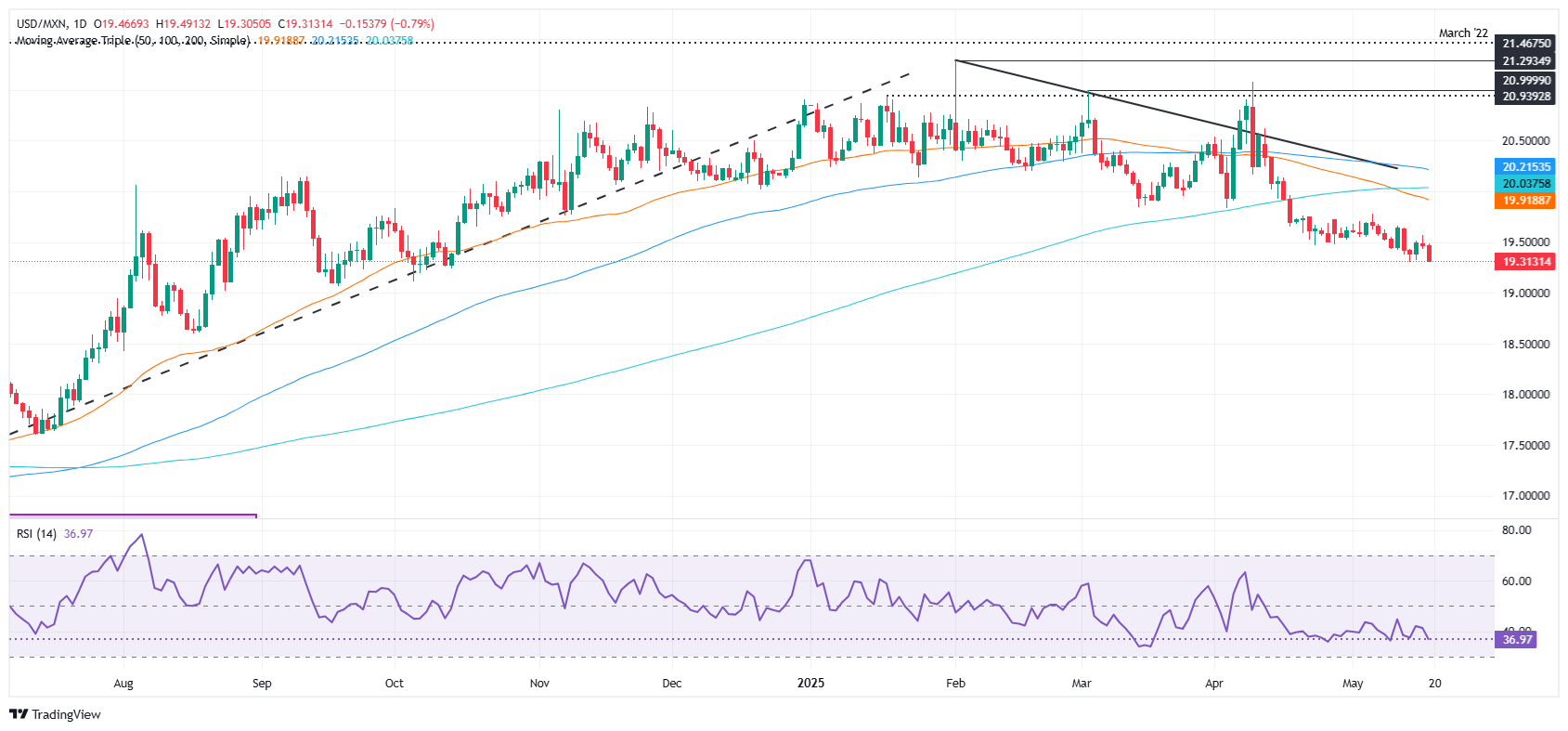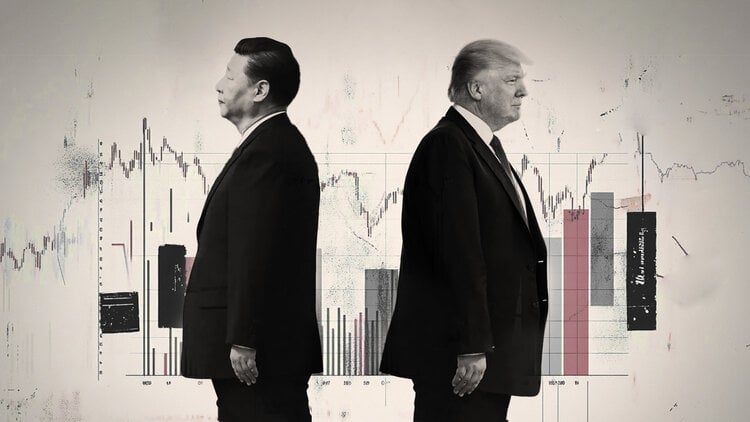- The Mexican weight can be seen while the USD/MXN remains about 19.30, with the Operators attentive to the GDP of Mexico and the next US data.
- The governor of Banxico maintains a moderate tone, while the IOAE of Mexico suggests that the economy stagnated in April.
- Moody’s reduces US debt to AA1, citing fiscal inaction; The USD weakens in general in the midst of concerns about long -term debt.
The Mexican peso (MXN) advanced 0.60% against the US dollar (USD) on Monday, since investors moved away from the dollar before the review of the Moody’s International Qualification Agency on the debt prospects of the US government.
The market appetite has improved as the session progresses, since the operators dismissed the Moody’s news. The International Agency reduced the debt qualification of the US government of AAA to AA1, citing that the inaction of successive administrations and the US Congress. UU. It has contributed to the deterioration of the country’s fiscal position, generating concerns about the sustainability of long -term debt.
The governor of the Bank of Mexico (Banxico), Victoria Rodríguez Ceja, crossed the news lines and remained moderate. The news of the National Statistics Agency of Mexico warned that the economy probably stagnated in April, according to the timely indicator of economic activity.
Meanwhile, some Federal Reserve officials (FED) crossed the news lines.
The operators are attentive to the publication of retail sales of Mexico and the figures of the Gross Domestic Product (GDP). In the US Front., Investors will digest the figures of the PMI Flash of Global S&P, as well as housing and employment data.
Daily movements of the Mexican weight market: Weight ready to extend profits
- The governor of Banxico, Victoria Rodríguez Ceja, said that monetary policy will remain restrictive, but hinted that there is room to reduce the reference interest rate, he said in an interview published by El Financiero.
- Last week, Banxico reduced his 8.50%rates, citing the need for additional calibration of monetary policy and anticipating greater relief. The Central Bank predicts that general inflation will converge the 3% target for the third quarter of 2026.
- Inegi revealed the results of the timely indicator of economic activity (IOAE), with figures that remain unchanged in 0% in April compared to the contraction of -0.2% of March.
- Analysts surveyed by El Economista project that the main reference rate of Mexico will be around the range of 7.25% to 7.75% by the end of 2025.
- Fed officials, Raphael Bostic, John Williams and Philip Jefferson, agreed that the current monetary policy position remains appropriate due to uncertainty about tariffs. Williams said the economic data has been solid and coincided with Jefferson’s concerns about tariffs that could trigger a re-beaten of inflation. Bostic projects a rate cut in 2025.
- The Futuro Future Fund Contract of December 2025 shows that market participants expect 52 basic relief points.
Technical perspective of the USD/MXN: The Mexican weight shoots while the USD/MXN is ready to close the day below 19.35
The USD/MXN maintains a downward bias, but the vendors have failed to refresh the minimums of the year to date (YTD) of 19.29 reached on May 14, which, once exceeded, could pave the way for a greater fall. The relative force index (RSI) shows that bassists are still in charge. That said, the exotic pair could re -test the figure of 19.00, last reached on August 21, 2024.
In that result, the following USD/MXN support would be 18.50, followed by the psychological brand of 18.00. On the contrary, buyers must recover 19.50 to maintain higher prices, with the first resistance seen in 19.53, the simple mobile average (SMA) of 20 days, followed by the 50 -day SMA in 19.90.

Mexican weight FAQS
The Mexican weight (MXN) is the most commercialized currency among its Latin American peers. Its value is widely determined by the performance of the Mexican economy, the country’s central bank policy, the amount of foreign investment in the country and even remittance levels sent by Mexicans living abroad, particularly in the United States. Geopolitical trends can also affect MXN: for example, the Nearshoring process (or the decision of some companies to relocate the manufacturing capacity and supply chains closer to their countries of origin) is also considered a catalyst for the Mexican currency, since the country is considered a key manufacturing center in the American continent. Another catalyst for MXN is oil prices, since Mexico is a key exporter of the raw material.
The main objective of the Central Bank of Mexico, also known as Banxico, is to maintain inflation at low and stable levels (in or close to its 3%target, the midpoint of a tolerance band between 2%and 4%). To do this, the bank establishes an adequate level of interest rates. When inflation is too high, Banxico will try to control it by raising interest rates, which makes the indebtedness of homes and companies more cooling, thus cooling the demand and the economy in general. The highest interest rates are generally positive for Mexican weight (MXN), since they lead to higher yields, which makes the country a more attractive place for investors. On the contrary, lower interest rates tend to weaken the MXN.
The publication of macroeconomic data is key to evaluating the state of the economy and can have an impact on the valuation of the Mexican weight (MXN). A strong Mexican economy, based on high economic growth, low unemployment and high confidence is good for MXN. Not only attracts more foreign investment, but it can encourage the Bank of Mexico (Banxico) to increase interest rates, particularly if this fortress is accompanied by high inflation. However, if the economic data is weak, the MXN is likely to depreciate.
As an emerging market currency, the Mexican weight (MXN) tends to rise for periods of risk, or when investors perceive that the general market risks are low and, therefore, are eager to participate in investments that carry a higher risk. On the contrary, the MXN tends to weaken at times of market turbulence or economic uncertainty, since investors tend to sell higher risk assets and flee to the most stable safe shelters.
Source: Fx Street
I am Joshua Winder, a senior-level journalist and editor at World Stock Market. I specialize in covering news related to the stock market and economic trends. With more than 8 years of experience in this field, I have become an expert in financial reporting.







